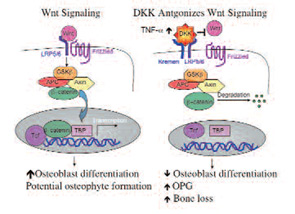To examine the role of DKK-1 in inflammatory arthritis, Diarra and colleagues used a monoclonal antibody to mouse DKK-1 in three separate models of murine arthritis. Although treatment with an anti-TNF antibody diminished paw swelling, anti–DKK-1 administration had no effect on paw size. However, anti–DKK-1 protected against bone erosion and there was an increased formation of bony nodules (osteophytes) at the joint margins in the anti–DKK-1 treated animals. Fewer erosions also correlated with fewer osteoclasts seen in the anti–DKK-1 treated animals. An additional effect of anti–DKK-1 treatment on inhibiting bone resorption was the associated increase in osteoprotegerin (OPG) expression. OPG is a soluble antagonist for the receptor activator of NF-kB ligand (RANKL), a critical factor for osteoclast differentiation. The effect of anti–DKK-1 on resorption appeared to be secondarily mediated through OPG. After experimental reduction in articular OPG expression, the osteoclasts re-emerged in anti–DKK-1–treated animals, supporting this hypothesis. In previous reports, DKK-1 had been found to suppress osteoblast differentiation. Hence, DKK-1 might toggle the balance between bone repair and resorption

Although the source of systemic DKK-1 remains unclear, inflamed synovium from RA patients was shown to express DKK-1 locally in the joint. In addition, fibroblast-like synoviocytes were induced to express DKK-1 by exposure to TNF-a in culture. As a correlate, serum levels of DKK-1 declined progressively during six weeks in RA patients who were started on anti-TNF therapy. In addition, serum levels of DKK-1 were proportional to their disease activity score (DAS) 28, whereas ankylosing spondylitis patients had low baseline levels of circulating DKK-1.
This elegant series of experiments suggests that DKK-1 or other Wnt signaling modulators might prove to be useful therapeutic targets for therapies to reduce bone erosion in RA. However, in addition to attenuating bone erosion the experimental mice had aberrant bony proliferation, suggesting that osteophyte formation may be a potential side effect that would require monitoring. In addition, the Wnt pathway regulates multiple cellular functions including proliferation and differentiation. Wnt signaling antagonists have been reported as key molecules in tumor suppression, angioneogensis, and cardiac disease amongst other potential comorbidity issues. These initial findings by Diarra et al. are very promising in a potential new target to abrogate bone erosion, but further investigating into the effects on other organ systems is warranted.
References
- Glass DA, 2nd, Karsenty G. In vivo analysis of Wnt signaling in bone. Endocrinology. 2007, Mar 29; (Epub ahead of print).
- Boyden LM, Mao J, Belsky J, et al. High bone density due to a mutation in LDL-receptor-related protein 5. N Engl J Med. 2002;346(20):1513-1521.
- Gong Y, Slee RB, Fukai N, et al. LDL receptor-related protein 5 (LRP5) affects bone accrual and eye development. Cell. 2001;107(4):513-523.